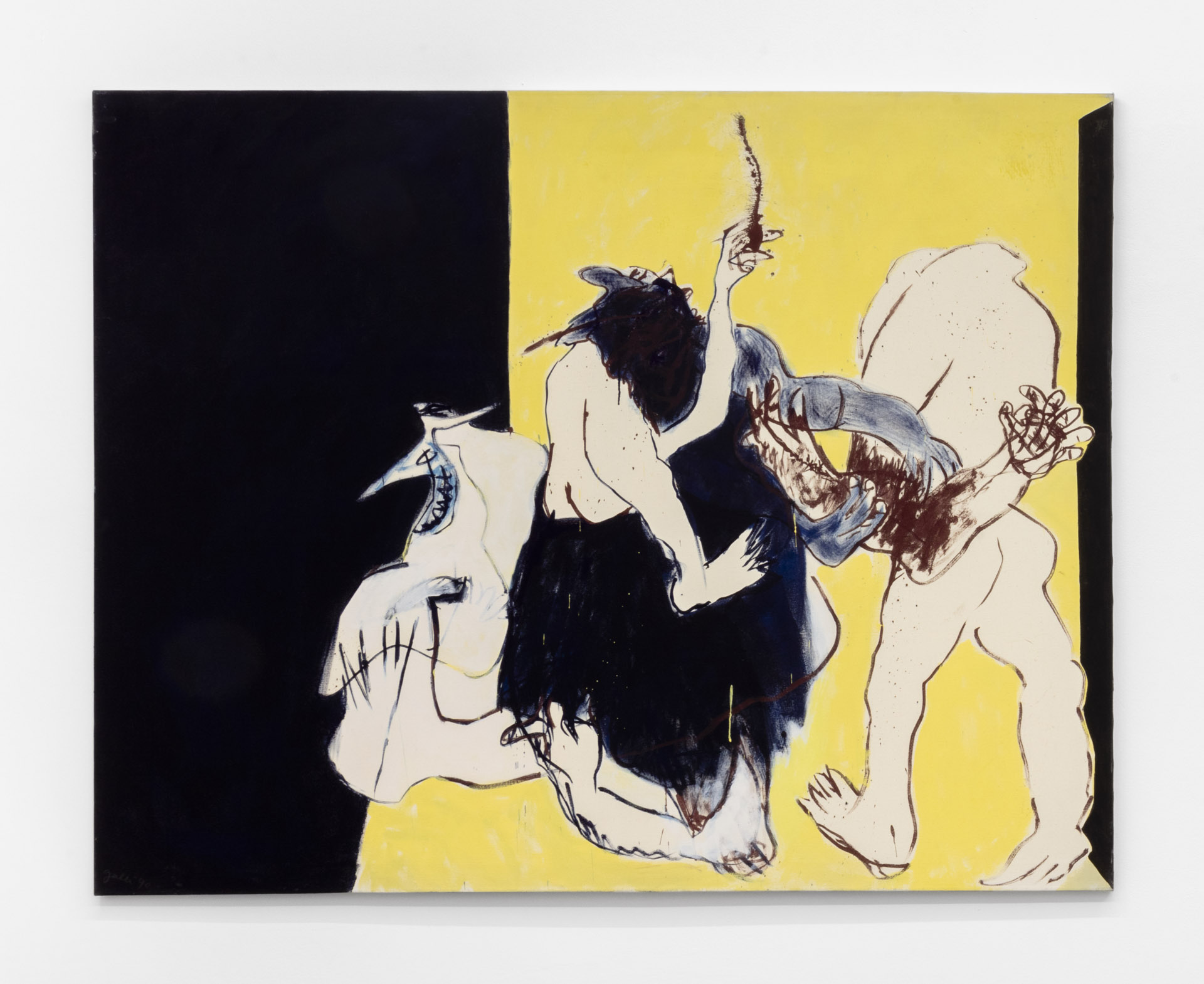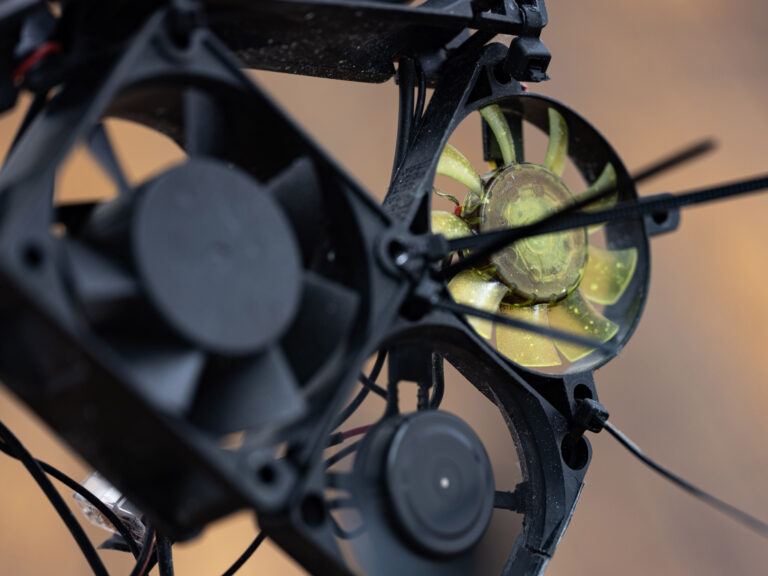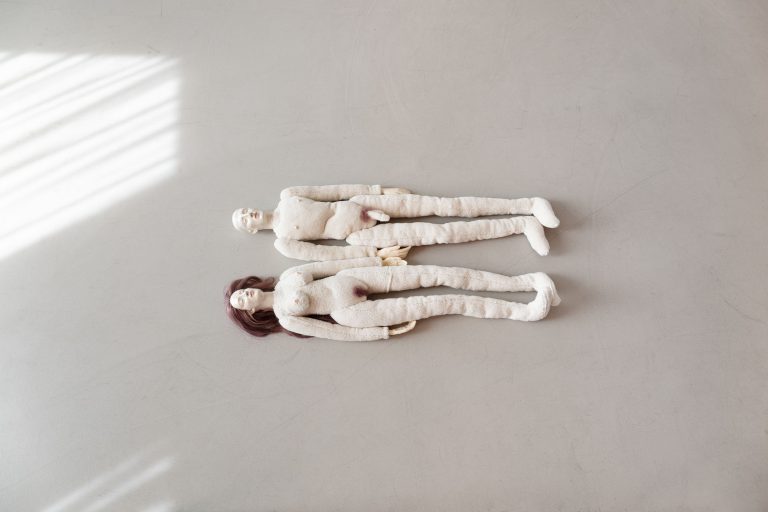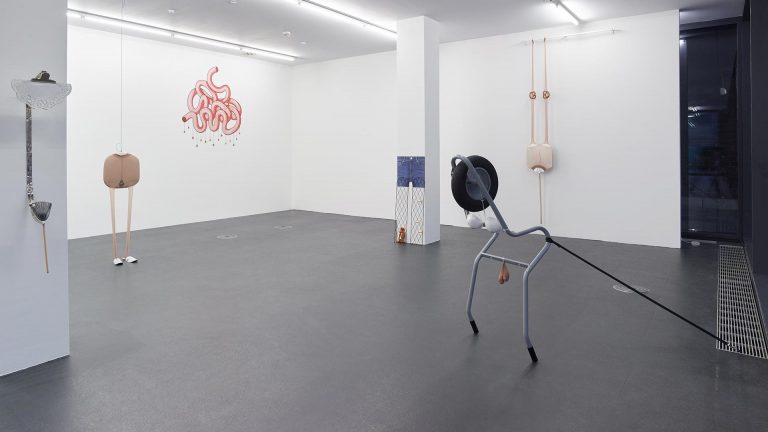Artist: Galli
Exhibition title: Absage ans Paradies
Venue: brunand brunand, Berlin, Germany
Date: November 11, 2021 – January 8, 2022
Photography: all images copyright and courtesy of the artist and brunand brunand, Berlin
The monster appears in Galli’s paintings not as a specific psychoanalytic or mythological entity, but as an interface for painterly representation in general. Through it, she articulates a deeply enigmatic take on the body and its encounters with violence, desire, commodities, and animals, amongst many other things, interpolating these motifs in grotesque, if charming, amorphous figures and spaces.
Born in 1944 in Saarland, former West Germany, Galli established herself in the West Berlin art scene in the late 1970s and early 1980s. A contemporary to the Die Neuen Wilden in Germany, she rejected the rigidness of conceptual art in favor of gestural brushstroke and figuration with an expressive corporeality at its center. In the decades to come, Galli became a prominent fixture of her generation in Germany, presenting solo exhibitions in countless galleries as well as Forum Kunst Rottweil, the Bodensee Museum in Friedrichshafen, and the Salzburger Kunstverein. Decades later, her works were on view last year in the 11th Berlin Biennale.
Galli’s first exhibition with brunand brunand presents 5 paintings, most of them completed by Galli during her residency at the Villa Romana in Florence, Italy, in 1990. In addition, a group of approximately 90 index cards drawn from ballpen is on display, a quick sketching method that the artist has employed throughout her prolific career.
Galli’s painterly strategy is at once visceral and self-reflexive; her forays into figuration are never presented without a commentary on the medium itself, a history she interrogates with a joyful and intellectual irreverence. Wer das Gelbe nicht ehrt (1981/1987) (“Who does not honor the yellow”) presents a nebulous and head-less grey body firmly holding onto a bone in front of a lemony yellow monochrome backdrop, while in Klassisches Getümmelbild (1990), a clump of abstract bodies assemble in commotion in front of a bi-chromatic color field suggesting a room or an architecture. As such, painting becomes a stage for confrontations between subject and form both haunted by history—be it art history or political history. Galli’s baroque figures, with their limbs protruding or seemingly multiplying, may allude to the grotesque corporeality of Goya and Rubens, but the artist transposes these into a one-dimensional, almost comic book-style contemporary, where they are allowed to shine, squirm, and be redeemed as proto-subjects. The morbid cartoon is most directly conveyed in her dramatic and narrative-heavy index cards, but it is also visible in Kentaur (für Schari!), 1990, where an amorphous horse-like figure with several human limbs seems to be nearly breaking through the enclosed space that surrounds it; its seemingly buoyant geist, conveyed in shades of red and ochre, is negated by the macabre motif that shows the creature stabbing its own arm with a knife and bleeding. Inversely, in o.T. (Monster von Firenze), 1990, a morbid scene depicts the notorious mass murder who in the 1990s traversed the streets of Florence, looming over one of his presumed subjects. Yet, with the artist’s wild-drawn lines, attention to the clutching of human hands, and generous use of crimson red, an erotic allegory feels pressing.
Galli explains her sudden employment of earth colors as a direct result of her time observing Tuscany’s landscape, and for registering the city of Florence itself. Rather than the postcard-like Renaissance city that many know it to be, the artist saw in its martial architecture, and dingy, narrow streets, the dark underbelly of the European humanist tradition of thought and of representation. Her deeply original morphology, transcending genre or style, are testaments to this antagonistic corporeal ethos: Galli’s bodies may be disfigured, mutated, disabled, but they all showcase an unmistakable lust and passion for life, for being and bodiliness in all its wondrous ambivalence.
GALLI: (…) The first conscious interiors appear in the paintings from Florence. This is certainly also due to Tuscany. Just the walls that surround the Villa Romana. You feel constantly enclosed, even in Florence itself, in the narrow streets. There’s also something funky about the landscape, like a huge garden. It’s all very fascinating at first, but little by little it squeezes you in. It’s like the anti-fairy tale in Büchner’s Woyzeck: a permanent disappointment. That’s something people don’t understand, that you don’t feel good in this paradise. As a result, you naturally have a guilty conscience forever, because you think: You must be doing well! Until you accept that it is not like that a lot of time goes by.
VERONIKA KLEINEDAM: And when they always say that Italy is so beautiful?
GALLI: Not true at all! Florence it’s black canyons. The Renaissance buildings are incredibly martial. Italian cities are unbearable. Siena, for example, is declared to be one of the most beautiful cities in Europe. So of course it’s fun to whiz through the alleys in your car and look: can I get through there now? But otherwise it has such a worn-out Agfacolor aesthetic; I don’t like it at all.
VERONIKA KLEINEDAM: Isn’t it different if you only go there on vacation?
GALLI: Italy is already great for that vacation thing. But when I hear all the moaning from people that they’ll emigrate if any party wins or doesn’t win, I think: they should! In this respect, Italy was important for me (laughs): the big rejection of paradise!
Fragment from the interview Absage ans Paradies, conducted in Berlin in August 1991.
Galli, Absage ans Paradies, 2021, exhibition view, brunand brunand, Berlin
Galli, Absage ans Paradies, 2021, exhibition view, brunand brunand, Berlin
Galli, Absage ans Paradies, 2021, exhibition view, brunand brunand, Berlin
Galli, Absage ans Paradies, 2021, exhibition view, brunand brunand, Berlin
Galli, Absage ans Paradies, 2021, exhibition view, brunand brunand, Berlin
Galli, Absage ans Paradies, 2021, exhibition view, brunand brunand, Berlin
Galli, Absage ans Paradies, 2021, exhibition view, brunand brunand, Berlin
Galli, Absage ans Paradies, 2021, exhibition view, brunand brunand, Berlin
Galli, Absage ans Paradies, 2021, exhibition view, brunand brunand, Berlin
Galli, Absage ans Paradies, 2021, exhibition view, brunand brunand, Berlin
Galli, Absage ans Paradies, 2021, exhibition view, brunand brunand, Berlin
Galli, Absage ans Paradies, 2021, exhibition view, brunand brunand, Berlin
Galli, Absage ans Paradies, 2021, exhibition view, brunand brunand, Berlin
Galli, Kentaur (für Schari!), 1990, Signed & dated on recto, Acrylic, emulsion & chalk on hessian (Acryl, Dispersion, Kreide auf Rupfen), 150 x 190 cm, 59 1/8 x 74 3/4 in
Galli, Klassisches Getümmelbild, 1990 Signed & dated on recto, Acrylic on nettle (Acryl auf Nessel) 150 x 190 cm, 59 1/8 x 74 3/4 in
Galli, Klassisches Getümmelbild, 1990 Signed & dated on recto, Acrylic on nettle (Acryl auf Nessel) 150 x 190 cm, 59 1/8 x 74 3/4 in
Galli, o.T. (Monster von Firenze), 1990 Signed & dated on recto, Acrylic on canvas (Acryl auf Leinwand) 150 x 120 cm, 59 1/8 x 47 1/4 in
Galli, o.T. (Monster von Firenze), 1990 Signed & dated on recto, Acrylic on canvas (Acryl auf Leinwand) 150 x 120 cm, 59 1/8 x 47 1/4 in
Galli, Wer das Gelbe nicht ehrt, 1981/1987, Signed & dated on recto & verso, Acrylic, chalk & tempera on nettle (Acryl, Kreide & Tempera auf Nessel), 125 x 100 cm, 49 1/4 x 39 3/8 in

























